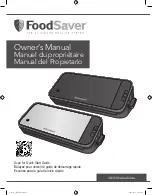
16
15
Consumer Service:
US: 1-877-777-8042 CA: 1-877-804-5383 MX: +52 55 5366 0800
US: www.FoodSaver.com | CA: www.FoodSaver.ca | MX: www.oster.com.mx/foodsaver
GU
IDE
LI
NE
S
GU
IDE
LINE
S
Food Preparation & Reheating Tips
IMPORTANT:
Due to the risk of anaerobic bacteria, fresh mushrooms, onions and garlic should never be
vacuum sealed.
Preparation Guidelines
for Vegetables:
Vegetables need to be blanched before vacuum sealing. This process stops the enzyme action
that could lead to loss of flavor, color and texture.
To blanch vegetables, place them in boiling water or in the microwave until they are cooked, but
still crisp. Blanching times range from 1 to 2 minutes for leafy greens and peas; 3 to 4 minutes
for snap peas, sliced zucchini or broccoli; 5 minutes for carrots; and 7 to 11 minutes for corn
on the cob. After blanching, immerse vegetables in cold water to stop the cooking process.
Finally, dry vegetables on a towel before vacuum sealing.
NOTE:
All vegetables (including broccoli, brussels sprouts, cabbage, cauliflower, kale, turnips)
naturally emit gases during storage. Therefore, after blanching, they must be stored in freezer
only.
When freezing vegetables, it is best to pre-freeze them for 1-2 hours or until solidly frozen.
To freeze vegetables in individual servings, first place on a baking sheet and spread them out
so they are not touching. This prevents them from freezing together in a block. Once they are
frozen, remove from baking sheet and vacuum seal vegetables in a FoodSaver
®
Bag. After they
have been vacuum sealed, return them to the freezer.
Preparation Guidelines
for Leafy Vegetables:
For best results, use a FoodSaver
®
Container to store leafy vegetables. First wash the vegetables,
and then dry with a towel or salad spinner. After they are dried, put them in a container and
vacuum seal as normal. Store in refrigerator.
IMPORTANT:
When vacuum sealing apples, they must be sliced, and put a small bit of lemon juice on
the slices to prevent them from browning.
Because of their natural ripening, bananas may actually decay faster under a vacuum seal.
Food Preparation & Reheating Tips
Preparation Guidelines for Fruits:
When freezing soft fruits or berries, it is best to pre-freeze them for 1-2 hours or until solidly
frozen. To freeze fruit in individual servings, first place on a baking sheet and spread them out
so they are not touching. This prevents them from freezing together in a block. Once they are
frozen, remove from baking sheet and vacuum seal fruit in a FoodSaver
®
Bag. After they have
been vacuum sealed, return them to the freezer.
You can vacuum seal portions for baking or in your favorite combinations for easy fruit salad all
year round. If storing in the refrigerator, we recommend using a FoodSaver
®
Container.
Preparation Guidelines
for Baked Goods:
To vacuum seal soft or airy baked goods, we recommend using a FoodSaver
®
Container so they
will hold their shape. If using a bag, pre-freeze for 1-2 hours or until solidly frozen. To save time,
make cookie dough, pie shells, whole pies, or mix dry ingredients in advance and vacuum seal
for later use.
Preparation Guidelines for
Coffee and Powdery Foods:
To prevent food particles from being drawn into Vacuum Pump, place a coffee filter or paper
towel at top of bag or container before vacuum sealing. You can also place the food in its
original bag inside a FoodSaver
®
Bag to vacuum seal.
VS2100_22EFSM1.indd 15-16
VS2100_22EFSM1.indd 15-16
2022/2/11 2:17 PM
2022/2/11 2:17 PM










































